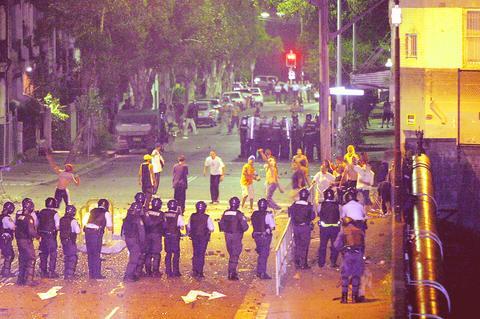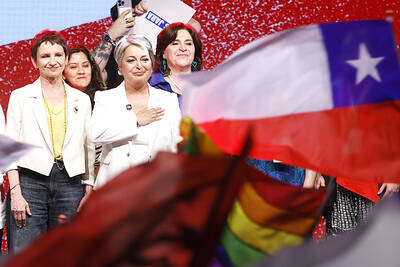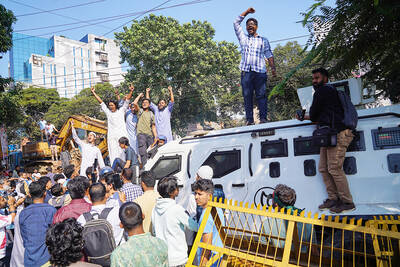The dried blood on the streets of Sydney's black ghetto yesterday following an overnight riot by Aborigines was a stark reminder of the continuing deep, and at times violent, divide between white and black Australia.
About 100 Aborigines, many of them drunk, pelted 200 riot police with Molotov cocktails, stones and bottles, as anger boiled over in the inner-city suburb of Redfern.

PHOTO: AFP
The riot was triggered by the death of Aboriginal Thomas Hickey, who was impaled on a metal fence after falling from his bicycle on Saturday. He died in a hospital on Sunday morning.
His mother, Gail, said her 17-year-old son was injured while being pursued by police. Police say patrolling officers merely passed by the boy who then sped off, losing control of his bike.
Senior Aboriginal leaders yesterday condemned the violence, the worst civil unrest in Australia's largest city for at least a decade, but said the riot reflected a wider issue -- the alienation of black Australia.
"People should not kid themselves -- this is Australia," said Aden Ridgeway, the only Aboriginal politician in the national parliament.
"Last night's display of violence is an extreme example of the extent of the alienation felt by some Aboriginal kids and the manifestation of the difficult relationships in the area."
Australia's 400,000 Aborigines and Torres Strait Islanders make up 2 percent of Australia's 20 million people.
Aborigines remain the nation's most disadvantaged group, dying 20 years younger than other Australians with far higher rates of imprisonment, unemployment, welfare dependency, domestic violence and alcoholism.
Most live in remote communities in Australia's outback, with smaller groups in squalid accommodation on the fringes of regional towns. Very few live in major cities.
Black Australia calls the arrival of white settlers in 1788 "the invasion." Thousands were massacred by white settlers or evicted from their ancestral lands.
And Aboriginal leaders say racism in Australia has dictated their lives ever since.
A public gathering by Aborigines in Redfern yesterday saw speaker after speaker express anger and frustration at how Aborigines were being treated.
"There is no such thing as [racial] reconciliation," said Lyall Munro, an Aboriginal elder in Redfern, citing the thousands of Aborigines in jails or juvenile detention centers.
It was not until a 1967 national vote by white Australians that Aborigines were actually granted citizenship. Until then they were governed under flora and fauna laws.
Aborigines in the remote Northern Territory gained land rights in 1976 after a long struggle, but Aborigines in the rest of the country are still fighting for land rights.
A 1997 report by Australia's human rights commission found an assimilation policy used by various Australian governments up to the 1960s was "systematic racial discrimination and genocide."
The report detailed the plight of the "Stolen Generation" children, taken from their parents to be raised in white families, but who were sexually abused or used as slave labor in Australia's vast outback.
It called for a government apology and compensation, but conservative Prime Minister John Howard will not issue an apology for past atrocities against Aborigines, saying Australians today have nothing to be sorry about.
In recent years Aboriginal leaders have moved away from calls for racial reconciliation to a more pragmatic call for help to tackle drug and alcohol abuse which is killing their people.
But white and black Australia rarely cross paths in this island continent and when they do tensions rise. White Australia says Aborigines are to blame for their own poverty, while Aborigines say racism dictates their plight.
"They're lucky they haven't got a guerrilla war happening," an angry Aborigine called Tammie told the Redfern meeting.
"Aboriginal people are peaceful people but [if] they push our buttons, mate, we will go to the point where if they're going to shed blood so will we," Tammie said.

DISASTER: The Bangladesh Meteorological Department recorded a magnitude 5.7 and tremors reached as far as Kolkata, India, more than 300km away from the epicenter A powerful earthquake struck Bangladesh yesterday outside the crowded capital, Dhaka, killing at least five people and injuring about a hundred, the government said. The magnitude 5.5 quake struck at 10:38am near Narsingdi, Bangladesh, about 33km from Dhaka, the US Geological Survey (USGS) said. The earthquake sparked fear and chaos with many in the Muslim-majority nation of 170 million people at home on their day off. AFP reporters in Dhaka said they saw people weeping in the streets while others appeared shocked. Bangladesh Interim Leader Muhammad Yunus expressed his “deep shock and sorrow over the news of casualties in various districts.” At least five people,

LEFT AND RIGHT: Battling anti-incumbent, anticommunist sentiment, Jeanette Jara had a precarious lead over far-right Jose Antonio Kast as they look to the Dec. 14 run Leftist candidate Jeannette Jara and far-right leader Jose Antonio Kast are to go head-to-head in Chile’s presidential runoff after topping Sunday’s first round of voting in an election dominated by fears of violent crime. With 99 percent of the results counted, Jara, a 51-year-old communist running on behalf of an eight-party coalition, won 26.85 percent, compared with 23.93 percent for Kast, the Servel electoral service said. The election was dominated by deep concern over a surge in murders, kidnappings and extortion widely blamed on foreign crime gangs. Kast, 59, has vowed to build walls, fences and trenches along Chile’s border with Bolivia to

DEATH SENTENCE: The ousted leader said she was willing to attend a fresh trial outside Bangladesh where the ruling would not be a ‘foregone conclusion’ Bangladesh’s fugitive former prime minister Sheikh Hasina yesterday called the guilty verdict and death sentence in her crimes against humanity trial “biased and politically motivated.” Hasina, 78, defied court orders that she return from India to attend her trial about whether she ordered a deadly crackdown against the student-led uprising that ousted her. She was found guilty and sentenced to death earlier yesterday. “The verdicts announced against me have been made by a rigged tribunal established and presided over by an unelected government with no democratic mandate,” Hasina said in a statement issued from hiding in India. “They are biased and politically motivated,” she

It is one of the world’s most famous unsolved codes whose answer could sell for a fortune — but two US friends say they have already found the secret hidden by Kryptos. The S-shaped copper sculpture has baffled cryptography enthusiasts since its 1990 installation on the grounds of the CIA headquarters in Virginia, with three of its four messages deciphered so far. Yet K4, the final passage, has kept codebreakers scratching their heads. Sculptor Jim Sanborn, 80, has been so overwhelmed by guesses that he started charging US$50 for each response. Sanborn in August announced he would auction the 97-character solution to K4